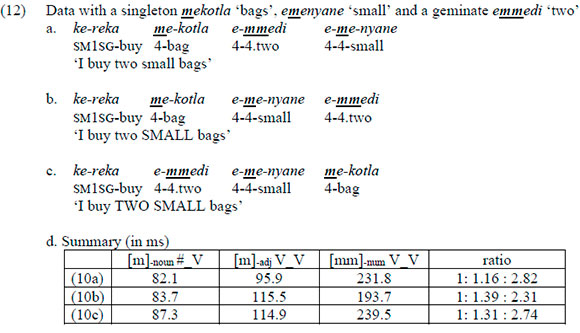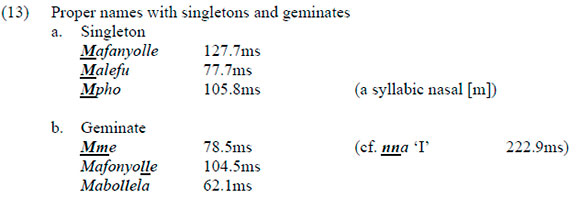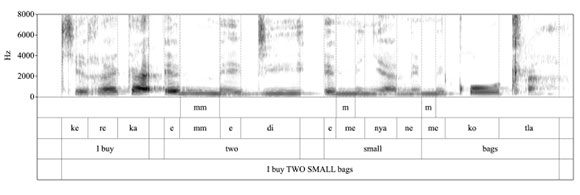Services on Demand
Article
Indicators
Related links
-
 Cited by Google
Cited by Google -
 Similars in Google
Similars in Google
Share
Stellenbosch Papers in Linguistics Plus (SPiL Plus)
On-line version ISSN 2224-3380
Print version ISSN 1726-541X
SPiL plus (Online) vol.67 Stellenbosch 2023
http://dx.doi.org/10.5842/67-1-1006
NTU (BANTU) LINGUISTICS
Kristina RiedelI; Seunghun J. LeeII
IDepartment of Linguistics, University of the Witwatersrand, South Africa. E-mail: kristina. riedel@wits.ac.za
IIPsychology and Linguistics, International Christian University, Tokyo, Japan | MER Mathivha Centre for African languages, Arts and Culture, University of Venda, Thohoyandou, South Africa. E-mail: seunghun@icu.ac.jp
1. Introduction
Geminates are a feature of Sesotho phonology. Only nasals and the lateral appear as geminates, to the exclusion of the other sonorants that form part of the Sesotho phonemic inventory. This squib reports on some phonetic and phonological aspects of Sesotho geminates, including duration, the phonotactic distribution of geminates and the syllabic structures in which they appear.
Sesotho is a Southern Bantu language of the Sotho-Tswana group (Guthrie code: S33) and is spoken primarily in South Africa and Lesotho by about 5,6 million first language speakers and several million L2 speakers (Eberhard et al. 2021). The language has the nasals /m, n, n, n/ and the liquids /l, r/. All of these sounds, except /r/, can appear as geminates.
Sesotho geminates are marked in the South African orthography by doubled-consonants, as shown in the form mmusi in example (1), but the descriptions of Sesotho sound inventories that we were able to locate do not discuss geminates at all (even while following the various orthographic conventions1 of marking them); they only distinguish between syllabic and non-syllabic nasals and liquids (Doke & Mofokeng 1957, Rose & Demuth 2006, Mohoanyane 2009), despite the fact that nasals can be onsets, form the nucleus of their own syllable and also appear as geminate. The example in (1) shows one of the phonological processes that result in geminates in Sesotho.2
The issues we touch on in this squib relate to the phonological distribution of geminates as well as phonetic and phonological processes. We discuss geminates as a syllabic nasal/liquid + onset nasal/liquid and geminates that contrast with a singleton sonorant. In section 2, we also look at how geminates are derived by phonological and morphological processes and which types of word classes and semantic clusters they appear in. In section 3, we look at some phonetic properties of geminates. In terms of duration, we show that in certain apparently phonologically determined contexts, geminates are degeminated. Section 4 offers some concluding remarks.
2. The morphophonology and semantics of Sesotho geminates
Geminates only seem to appear as the result of deleted vowels or phonological processes taking place at word or morpheme boundaries. However, as there are many of these contexts, geminates are quite a prominent feature of Sesotho phonology. On a diachronic level, Hyman (2003) describes how geminates arise from Proto-Bantu: (a) nasalization of a root-initial consonant after a nasal prefix in class 9/10, or (b) deletion of the vowel in the class 1 prefix. In Sesotho, the origin of geminates can be traced to both types of pattern and other processes of vowel deletion between identical consonants or consonants undergoing assimilation.
The closely related Tswana language also has geminate nasals and liquids, including the trilled [r] (Bennett et al. 2016:239) which is not found as geminate in Sesotho. Bennett et al. (2016) note that /ll/ is rare in Tswana, but this is not the case in Sesotho. Coetzee (2001) explains that geminates in Tswana have a syllable structure of C.CV and the data we present here matches this pattern with the exception of the locative suffix which always forms its own syllable as in jwa.ng.ng[n.n]4 (9.grass.LOC) 'in/at/on (the) grass'.
Sesotho geminates can be found in all word classes including nouns (of different classes and semantic categories), verbs, adjectives, numerals, pronouns, and other nominal modifiers. Nouns that include geminate consonants include nouns referring to humans, place names, names of animals and plants, objects and abstract nouns, a small number of words relating to body parts, loan words with initial nasals and deverbatives, including agentives, resultatives, tools, and instruments. The liquid geminate /ll/ is often observed in verbs with the applicative suffix or several other less productive extensions (see below) or in nouns that are derived from these.
As University of Botswana (2001, cited in Bennett et al. 2016:239) notes, geminates in Tswana typically appear where a penultimate vowel between two identical sonorants has been deleted.6Doke and Mofokeng (1957: 33) also derive what they refer to as syllabic sonorants in Sesotho from syncope. Words with a liquid geminate in Sesotho show cognates with the -IVl- sequence in Setswana, isiZulu, isiXhosa and Tshivenda ('Sotho phonology' 2021).

Verbs, especially applicative forms, including apparently lexicalised applicatives such as -bokella 'to gather, store' and -rupella 'to lecture' and different types of nouns derived from applied verbs, or verbs with applicatives and other extensions such as the reciprocal form geminates from a singleton /l/ in penultimate position (to which the -el of the applicative is added, followed by vowel deletion which creates the geminate as discussed above), as shown in (4).

Doke and Mofokeng (1957:168-9) describe a transitive reversive extension -oil (that they describe as productive) which includes a geminate (5a). Doke and Mofokeng (1957:170) also note a small number of verbs with a homophonous extension -oil (which they describe as "augmentative"). Other verbal extensions with a geminate consonant include the perfective -ell and the perfective-intensive -ellets (Doke & Mofokeng 1957:165-6). Examples of these are shown in (5b).

Another morphological source of geminates on verbs are object markers for class 1 (third person singular) and first person singular with verbs that have an initial nasal or bilabial, as shown in (6 a-c). We also found one example of a palatal singleton nasal that surfaces as a geminate velar nasal when the passive morpheme is attached (6d).

Nouns in classes with initial nasals frequently start with geminates, where the prefix and the stem-initial consonant undergo homorganic nasalization or the stem-initial consonant is already nasal. This includes classes 1/2 and 1a/2a as well as class 9/10 nouns. Examples come from animal names (7a), plant names (7b), loanwords (7c), body parts (7d), as well as adverbials and pronouns (7e). Doke and Mofokeng (1957: 64) note that many class 1a nouns with an initial geminate labial nasal are compounds based on the word mma 'mother', but they also note that many words with such a derivation have lost the geminate (surfacing with a singleton nasal).7

There also appears to be a semantic category of words with initial geminates that refer to information unknown or left out, as shown in (8). Some of these might have an ideophonic origin (such as the examples in 8a and 8b) rather than the phonological processes or the compounds based on mma 'mother', shown in (8c) and (8d), discussed above.

Geminates can appear in all logically possible positions of a phonological word in Sesotho, as shown in (9).

It is not clear if Sesotho words such as nna 'I' and nne 'four' (both of which seem to have cognates beyond Sotho-Tswana that feature geminates) include geminates that are not derived from the historical deletion of a vowel, or the other types of processes described above. But in any case, the geminates that are derived from deletion form part of a stem synchronically and speakers would likely consider these to be the basic shape of these stems. Further research into this matter needs to be conducted.
We observe three syllable patterns involving geminates in our Sesotho data, as listed in (10). Most commonly geminates are syllabic nasals followed by a nasal onset as in (10a). We assume the same applies to geminate liquids but more data on these is needed. The locative suffix assimilates to a previous velar nasal and forms a geminate as in (10b). Our data also shows degemination of geminates in proper nouns as in (10c). Geminate nasals contrast with syllabic but non-geminate nasals (e.g., m.pho 'gift') and nasals in onset position (mo.n.na. 'man').

3. Phonetic data
Based on the tokens we collected8 or had access to9 for geminate consonants the duration is roughly twice as long as for non-geminate counterparts. In Sesotho, both nasals and liquids contrast in duration resulting in the singleton versus geminate contrast. Bennett et al. (2016:239) note that in Setswana geminates (which Bennett et al. 2016 treat as doubled consonants because their study is purely phonetic) are three times longer than singleton consonants. A larger data set would be needed to determine whether this is a systematic difference between Sesotho and Setswana or just noise in the data.
In (11), examples that contain a singleton [m] and a geminate [mm] are examined, produced by a female speaker of Sesotho in her 30's. The duration of the geminate consonant is longer than that of the singleton consonant, but we observe some additional complexities in the data. Examples (11a) and (11b) have an object phrase that only contains the two target words: mekotla 'bags' and emmedi 'two'. In (11a), the numeral follows the head noun, while in (11b) it precedes the head noun.10 The durational measurements show that the geminate [mm] is about twice as long as the singleton [m], irrespective of the position of the numeral in relation to the head noun.
The examples in (12) are sentences with object nouns modified by an adjective and a numeral. The noun-numeral-adjective order in (12a) is the unmarked order in Sesotho. The other examples show more marked orders: the adjective precedes the numeral in (12b), and the head noun appears at the end of the noun phrase in (12c). The summary of duration of the singletons and the geminates in (12d) shows that the word-initial singleton in mekotla 'bags' is slightly shorter than the intervocalic singleton emenyane 'small', but the duration of these two types of singletons is much shorter than that of the geminate. The intervocalic geminate in (12a) is nearly three times as long as the word-initial singleton [m]. This kind of pattern has also been reported in phonetic studies of geminates in other languages such as Japanese (Kawahara 2015). See appendix A for the spectrograms of these examples.

Unexpectedly, geminates in names of people and places are degeminated as shown in (13). The duration of the singleton [m] is as long as the duration of the word-initial [m]'s reported in (11) and (12). The duration of the word-initial geminate in (13b) is also short. The duration of the degeminated geminate in (13b) contrasts with that of the word-initial geminate in words such as nna 'I'. Given that all geminates are produced short in proper names, we believe that degemination in proper names is a widespread phenomenon in Sesotho.

Bennett et. al. (2016: 240) also show that Tswana doubled consonants show an intensity discontinuity. Examining our data reveals a few cases that do show a discontinuation of intensity, but this intensity pattern was not consistent across all data. We speculate that the intensity discontinuity may occur only when a geminate is composed of a syllabic nasal and a nasal in onset position. This needs to be investigated further in future work.
4. Conclusion
This squib has described the basic phonological patterning and phonetic characteristics of geminates in Sesotho. Sesotho geminates arise from various morphophonological conditions and appear word-initially as well as word-medially and word-finally. In general, the duration of geminates is more than twice as long as that of singletons. In proper nouns, however, degemination is also found. Some geminates are decomposable as a combination of a syllabic consonant followed by an identical consonant. We, however, leave a detailed phonological analysis of these types of geminates for future research.
Acknowledgements
We thank the Sesotho speakers who took part in this research. This research was supported by the project grant 'Corpora of spoken language for Sesotho, Setswana and Sepedi' from the South African Centre for Digital Language Resources (SADiLaR) and JSPS KAKENHI Grant (B) #21KK0005 (JSAntu) 'Microvariation in Bantu languages of South Africa: building theories from typology data'; and the ILCAA joint research project 'Phonetic typology from cross-linguistic perspectives (PhonTyp)' (2021-2023).
We also wish to thank the two anonymous reviewers whose helpful comments and feedback improved this work and Will Bennett for discussion. Any errors or mistakes naturally remain our own.
References
Bennett, William. G., Maxine Diemer, Justine Kerford, Tracy Probert & Tsholofelo Wesi. 2016. Setswana (South African). Journal of the International Phonetic Association 46(2). 235246. https://doi.org/10.1017/S0025100316000050 [ Links ]
Chaphole, Rampasane S. 2006. Bua Sesotho: A multidimensional approach to the teaching and learning of Sesotho as a foreign language. Madison: NALRC Press. [ Links ]
Coetzee, Andries W. 2001. Nasal-only syllables in Tswana. In Graham Horwood & Se-Kyung Kim (eds.), RuLingPapers II. New Brunswick: Rutgers University. [ Links ]
Eberhard, David M., Gary F. Simons, and Charles D. Fennig (eds.). 2021. Ethnologue: Languages of the World. Twenty-fourth edition. Dallas, Texas: SIL International. Online version: http://www.ethnologue.com [ Links ]
Hyman, Larry. 2003. Segmental Phonology. In Derek Nurse, Gérard Philippson (eds.) The Bantu Languages. Routledge. 42-58.
Kawahara, Shigeto. 2015. The phonetics of sokuon, or geminate obstruents. In H. Kubozono (ed.) Handbook of Japanese Phonetics and Phonology. Mouton de Gruyter. 43-78. https://doi.org/10.1515/9781614511984.43
Lee, Seunghun J. & Kristina Riedel. 2021. Pre-nominal DP modifiers and penultimate lengthening in Xitsonga. Stellenbosch Papers in Linguistics Plus 62. 107-134. https://doi.org/10.5842/62-0-907 [ Links ]
Lee, Seunghun J. & Kristina Riedel. 2023. Recursivity and focus in the prosody of Xitsonga DPs. Languages 8(2): 150. https://doi.org/10.3390/languages8020150 [ Links ]
Mabille, A. & H. Dieterlen. 2011. Sesuto-English dictionary. Morija: Morija Sesuto Book Depot. [ Links ]
Mohoanyane, 'Mapapali Angelina. 2009. Nasal influence in Sesotho phonology. PhD thesis. National University of Lesotho.
Rose, Yves & Katherine Demuth. 2006. Vowel epenthesis in loanword adaptation: representational and phonetic considerations. Lingua 116(7). 1112-1139. https://doi.org/10.1016/j.lingua.2005.06.011 [ Links ]
Sesiu sa Sesotho National Lexicography Unit. 2015. English-Sesotho Dictionary. South African National Lexicography Units.
University of Botswana, Department of African Languages and Literature. 2001. The Sound system of Setswana, 2nd edition. Gaborone: Lightbooks. [ Links ]
Sotho phonology. n.d. Wikipedia, The Free Encyclopedia. https://en.wikipedia.org/wiki/Sothophonology (Accessed December 15, 2021.)
1 In the Lesotho orthography geminates are indicated with an apostrophe preceding the geminate consonant (e.g., 'musi 'governor') when they appear in word-initial position. In this paper, we double the consonant instead, following the South African orthography.
2 We indicate the noun classes of nouns used in examples with numbers. Bantu noun classes are typically paired for singular plurals (1/2, 3/4, ...) up to class 14. Classes 1a/2a are singular/plural nouns referring to humans that do not show the regular class 1/2 prefix. Where our examples are morphologically complex, we use the following glossing abbreviations: CL = noun class marker, DJ= disjoint marker, INF = infinitival prefix, OM = object marker, SM = subject marker; with numbers indicating the noun class or 1/2S/P indicating first or second person singular or plural.
3 As shown in Mohoanyane (2009:4) voiced and voiceless obstruents and sonorants undergo changes in the context of nasals but the bilabial examples are the only ones we are aware of that are involved in geminate formation.
4 The lexical stem jwang 'grass' ends in a velar nasal and the locative suffix -(e)ng loses its vowel when attached to the nasal.
5 In the absence of detailed phonetic representation in our sources, IPA representations will only be used for palatal geminates [nn] and velar geminates [nn]. Sesotho has two orthographies in use in South Africa and Lesotho respectively while older sources use different systems again, so we have adjusted examples from all sources to South African orthography.
6 This implies that the processes which create geminates in Setswana might be more restricted than in Sesotho, where geminates appear in different positions (including final, medial and initial where those are not also penultimate) and where underlying consonants are not identical but undergo assimilation.
7 The derivations for these compounds are not provided in the sources and we do not have our own data for this. Seeing as noun class prefixes may have been deleted or other sound changes could have occurred due to compounding we do not attempt to provide derivations for these words here.
8 Data used here was collected in Qwaqwa in November 2021 by 'Maseanakoena Mokoaleli and Kristina Riedel, with ethical clearance from the General/Human Research Ethics Committee (GHREC) at the University of the Free State with approval number UFS-HSD2021/1175/21 and for a study into penultimate lengthening by the two authors of this paper with ethical clearance number UFS-HSD2019/1800/0311.
9 We wish to highlight and commend the very detailed discussions and audio recordings on the Wikipedia pages for Sesotho phonology https://en.wikipedia.org/wiki/Sothophonology_and_Sesotho_tonology https://en.wikipedia.org/wiki/Sothotonology_primarily_written_by_Tebello_Thejane (user name: Zyxoas) who also recorded minimal pairs that are available for download on these pages. We analysed these recordings with Praat and they provided very helpful baselines and overviews.
10 This kind of variation is analysed in detail in Lee and Riedel (2021).
11 Adjectives in Sesotho take two noun class agreement markers. For class 4 the prefixes are e- and me- where in this context the second prefix loses its vowel and becomes geminate due to homoganic nasalisation of the stem-initial consonant of -bedi 'two'.
Appendix A. Spectrograms
I. Spectrogram of the sentence (12a): 82.1ms for [m] in 'bags', 231.8ms for [mm] in 'two', and 95.9ms for [m] in 'small.'

II. Spectrogram of the sentence (12b): 83.7ms for [m] in 'bags', 115.5ms for [m] in 'small', and 193.7ms for [mm] in 'two.'

III. Spectrogram of the sentence (12c): 239.5ms for [mm] in 'two', 114.9ms for [m] in 'small', and 87.3ms for [m] in 'bags.'


















